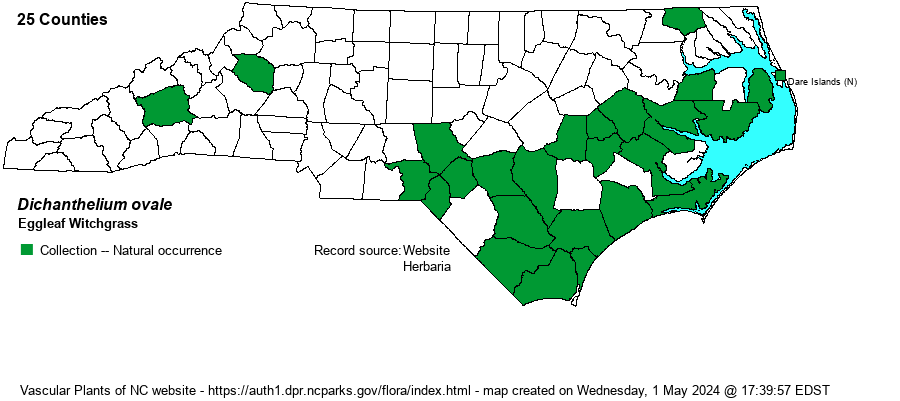| Author | (Elliott) Gould & Clark | |
| Distribution | Coastal Plain and Sandhills; disjunct to the low Mountains.
MA to MN, south to FL and TX; Mex. | |
| Abundance | Fairly common to common in the Coastal Plain and Sandhills, but rare in the low Mountains. | |
| Habitat | Dry to xeric (to mesic) sandy soil of pine and pine-oak-hickory woodlands, sand ridges, clearings, fields, roadsides. | |
| Phenology | Flowering and fruiting May-October. | |
| Identification | By gestalt, this is an "ordinary-looking" witchgrass, about 1 (-2) feet tall. It is more-or-less densely hairy on the stem, nodes (hairs ascending or erect), and leaves. It resembles the widespread D. acuminatum ssp. acuminatum, but spikelets are longer (2.1-2.6 mm vs. 1.6-1.9 mm). | |
| Taxonomic Comments | Two varieties occur in NC, with var. addisonii being the more widespread one and the nominate one being rather limited in range.
A note about Dichanthelium: This genus is not impossible to identify to species! But it takes applied effort over a period of time in order to learn the various species and what their morphological limits are. We strongly recommend that you read the introduction to the treatment in Weakley et al. (2023), written by Richard LeBlond. LeBlond has made order out of near chaos, and his keys work very well for our plants. Most Dichanthelium taxa ("Dichs") do not grow everywhere indiscrimminately, but prefer certain well-defined habitats. Note that most species produce flowers/fruits twice a year -- a vernal period and an autumnal period -- and that measurements of spikelets and achenes are taken from vernal plants. Some species also have a third, or summer, period. In the vernal period there is a single inflorescence at the tip of the stem. In the autumnal period, plants produce elongate branches with bunched (congested) leaves and so look quite different from vernal plants. Inflorescences are produced in leaf axils as well as at the tips of branches. NOTE: Older texts had these species essentially all within the very large genus Panicum. "Dich" species are typically named as "Witchgrass" and Panicum species named as "Panicgrass". | |
| Other Common Name(s) | Eggleaf Rosette Grass is the main common name in use, but this website is using "witchgrass" as the group common name for Dichanthelium species, rather than "rosette grass". | |
| State Rank | S2S3 [S3] | |
| Global Rank | G5 | |
| State Status | | |
| US Status | | |
| USACE-agcp | FACU link |
| USACE-emp | FACU link |

